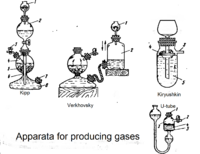Kipp's apparatus
Kipp's apparatus, or Kipp apparatus, or Kipp generator, is a device used to produce gases. It uses flowing of liquids regulated by gas pressure to start and stop reactions.
Contents
Design
The apparatus consists of three glass bulbs and resembles a snowman. The upper bulb is separate from the other two and is connected with the lower bulb by a long "tail" with which it is inserted into the apparatus. The lower and the middle bulbs are connected by a short "neck". The upper bulb is a reservoir for a liquid reagent. The middle bulb is a reservoir for a solid reagent and the place where the reaction occurs. It has a tube with a stopcock through which the gas leaves the apparatus. The lower bulb also acts as a reservoir for the liquid reagent and serves as the place where the reagent stays while the pressure in the middle bulb keeps it there.
When the stopcock is closed, the liquid reagent stays in the upper and lower bulbs, the pressure in the middle bulb keeps it from flowing there. When the stopcock is opened, the pressure in the middle bulb lowers, and the liquid reagent enters the middle bulb.
Reagents
The necessary conditions for the apparatus to work properly are the following:
- One reagent must be solid and the other liquid or solvated;
- The solid reagent must not be soluble in the liquid reagent;
- The solid reagent must react with the liquid reagent, evolving a gas;
- The solid reagent must not be a catalyst, it should be expended in the reaction. Otherwise any small piece of the solid reagent that accidentally slips into the lower bulb causes an unstoppable reaction followed by ejection of the liquid reagent through the top of the upper bulb.
Instead of a solid insoluble reagent, an inert porous material such as pumice impregnated with a soluble or second liquid reagent can be used.
The choice of reagents depends on what gas do you want to produce:
- Carbon dioxide: chalk or marble (solid reagent); any acid (liquid reagent);
- Hydrogen: zinc, iron or another metal with a middle level of reactivity (solid reagent); any acid except nitric (liquid reagent);
- Oxygen: calcium hypochlorite (solid reagent); hydrogen peroxide, acidified by a small amount of nitric acid (liquid reagent);
- Chlorine: manganese dioxide (solid reagent); hydrochloric acid (liquid reagent);
- Nitrogen: pumice impregnated with sodium nitrite (solid reagent); a solution of ammonium chloride (liquid reagent);
- Ammonia: calcium oxide (solid reagent); a solution of ammonium chloride (liquid reagent);
- Nitrogen monoxide: copper (solid reagent); diluted nitric acid (liquid reagent);
- Nitrogen dioxide: copper (solid reagent); concentrated nitric acid (liquid reagent);
- Sulfur dioxide: pumice impregnated with sodium metabisulfite (solid reagent); concentrated sulfuric acid (liquid reagent);
- Ozone: barium peroxide (solid reagent); concentrated sulfuric acid (liquid reagent);
- Methane: aluminium carbide (solid reagent); water (liquid reagent);
- Acetylene: calcium carbide (solid reagent); water (liquid reagent);
- Hydrogen sulfide: iron sulfide (solid reagent); any acid (liquid reagent);
Technically, any gas that can be evolved from a chemical reaction in a liquid medium under normal conditions can be produced in a Kipp apparatus. If you make a Kipp apparatus out of solid platinum and heat it up, you'll be even able to make fluorine in it via the Christe reaction. Of course, it is impossible to do in a normal glass apparatus.
Safety
Be careful when using the Kipp apparatus to synthesize flammable gases. An explosive gas-air mixture can form in the apparatus. Do not directly set the gas that exits it on fire, or Kipp's apparatus may explode. Put a gas washing bottle between the apparatus and the burner / nozzle to prevent Kipp apparatus explosions.
Similar apparata
Kipp's design is not the only. For large volumes of gases, Gay-Lussac and Verkhovsky apparata can be used. For small volumes of gases, the Kiryushkin apparatus or the U-tube apparatus can be used.
The Verkhovsky apparatus is notable in that it can be made from an old Kipp apparatus with a missing or broken upper bulb.
